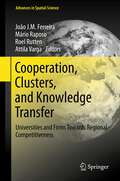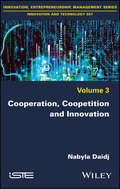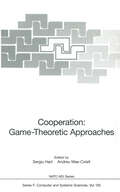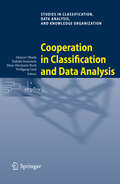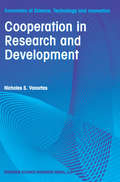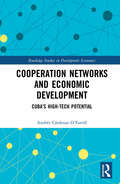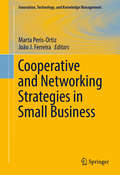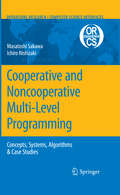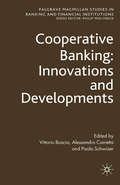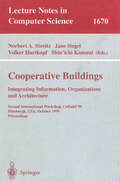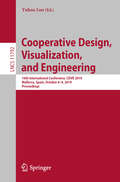- Table View
- List View
Cooperation and Technological Endowment in International Joint Ventures: German Firms in China (Edition KWV)
by Michael HoeckA frequent choice for market entry to China is the international joint venture (IJV) with a Chinese partner. This is regarded as an adequate market entry if complex technological knowledge is to be transferred to the new location. However, IJVs also represent an easy way for local partners to absorb technological knowledge without authorization.Michael Hoeck investigates the character and the degree of technology transfer into IJVs, using the example of German industrial firms in China. The two central questions that are investigated are „What factors influence the sophistication of the technological endowment that an IJV in China receives from its German parents?“ and „In what way do strategic considerations regarding inter-firm cooperation and knowledge sharing influence the foreign investor’s technology transfer behaviour?“.The study results – derived from theoretical and empirical analysis – presents novel insights to both researchers and practitioners.
Cooperation Between Antitrust Agencies at the International Level
by Bruno ZanettinThe issue of international antitrust enforcement is high on the agenda for both developed and developing countries. Bilateral cooperation between antitrust agencies, in particular the European Commission and US agencies, is the focus of this new work. It first shows how bilateral cooperation was developed as a response to the limits of the unilateral and extraterritorial application of national competition laws, and how it has evolved from an instrument initially designed to avoid conflicts into a tool aimed at coordinating joint investigations of international competition cases. It then considers how bilateral cooperation could be used optimally, by analysing two forms of advanced cooperation: the exchange of confidential information, and positive comity, which is the only satisfactory answer competition law can provide to market access cases. It shows that the use of such instruments is limited by significant legal and political obstacles, even in the context of the exemplary EC US relationship.The book therefore argues that the efficient use of bilateral cooperation will be limited to a small number of well-established competition agencies. If international anticompetitive practices are to be efficiently addressed by an increasingly large and heterogeneous group of competition agencies, horizontal cooperation between antitrust agencies must be complemented by a multilateral and supranational solution going beyond proposals currently put forward. The book concludes that only the WTO and its dispute settlement system could provide the basis for such a system.
Cooperation Between Companies and Non-profit Organizations: Taking Responsibility Together: Guidelines for Constructive, Credible and Transparent CSR Projects
by Gabriele Faber-Wiener Bettina GjecajThis book describes how cooperation between companies and non-profit organizations can be successfully structured. Companies want and need to take on more social responsibility, and joint projects with non-profit organizations are therefore more in demand than ever. This is not about maximizing profits through greenwashing or token commitments, but about serious corporate social responsibility projects and purpose strategies that strengthen the reputation on both sides. This requires a structured, transparent approach from the outset.The authors explain the theoretical basis and provide practical guidance on how the initiation of cooperation projects can lead to a credible and sustainable collaboration with added value for all stakeholders. An elementary part of the book is the "Code for Transparent Cooperation", a proven framework that can be applied directly in practice.A book for CSR, communication, marketing and compliance managers in companiesand non-profit organizations who strive for clear rules and an open dialogue at eye level.Anyone who acts as a credible driver of transformation would do well to operate sustainably themselves. Transparency creates credibility and reliability. The more an organization's goals shape the design of partnerships with companies, the more authentic they can appear to the outside world. This guide provides helpful tips and orientation on how to achieve coherence.Dipl.theol. Yvonne Zwick, Chairwoman of B.A.U.M. e.V. - Network for Sustainable Management, HamburgNon-profit organizations are central pillars of our society. Especially in times of disruption and change, their performance is of increasing importance. The prerequisite for this is independence - also in cooperation with companies. This book helps companies and non-profit organizations to understand their counterparts and establish stable collaborations.Dr. Günther Lutschinger, Managing Director of Fundraising Association Austria, ViennaThe time for lone wolves is over. If we are to achieve the Paris climate targets, companies must offer profitable solutions for people and the planet. It's all about: How do I tackle it? The new book by Gabriele Faber-Wiener and Bettina Gjecaj focuses in particular on partnerships with non-profit organizations and aims to prepare the ground for successful collaboration.Daniela Knieling, Managing Director respACT and Network Representative Global Compact Network Austria, ViennaCredibility, responsibility and transparency are the guarantee and basis for the sustainable development of companies. A thriving, trusting cooperation between companies and non-profit organizations helps to answer political and social questions and is a profound approach to solving complex ecological problems.Ernst Ternon, MBA MSc MSc, Head of Green Marketing, Wieselburg Campus, Wiener Neustadt University of Applied Sciences
Cooperation, Clusters, and Knowledge Transfer: Universities and Firms Towards Regional Competitiveness (Advances in Spatial Science)
by João J. M. Ferreira, Mário Raposo, Roel Rutten and Attila VargaCooperation and clusters have become the guiding paradigms for explaining and promoting regional competitiveness, but the cooperation process between firms and universities and the transfer of knowledge in guiding and nurturing regional competitiveness has received relatively little attention. This book strives to fill this gap in highlighting the connection between inter-firm cooperation in regional clusters, innovation and regional networks, and the role of universities in them . It goes beyond the traditional economic approach of clusters and includes ‘soft factors’ in the explanation of regional competitiveness, and connects the literature on clusters to the literature of learning and knowledge creation as sources of regional competitiveness. It aims to foster an international and interdisciplinary exchange of perspectives by presenting current developments, case studies, best practices as well as new integrated theoretical approaches and applications.
Cooperation, Coopetition and Innovation
by Nabyla DaidjIn presenting the concepts and the logical structure of the reasoning offered by game theory and their applications, the book explains the rational process of decision making in the framework of firm management and market competition. The book will expose both general teachings and a comprehensive analysis applied to specific case studies of various sectors of the economy.
Cooperation, Coopetition and Innovation
by Nabyla DaidjIn presenting the concepts and the logical structure of the reasoning offered by game theory and their applications, the book explains the rational process of decision making in the framework of firm management and market competition. The book will expose both general teachings and a comprehensive analysis applied to specific case studies of various sectors of the economy.
Cooperation: Game-Theoretic Approaches (NATO ASI Subseries F: #155)
by Sergiu Hart Andreu Mas-ColellIssues relating to the emergence, persistence, and stability of cooperation among social agents of every type are widely recognized to be of paramount importance. They are also analytically difficult and intellectually challenging. This book, arising from a NATO Advanced Study Institute held at SUNY in 1994, is an up-to-date presentation of the contribution of game theory to the subject. The contributors are leading specialists who focus on the problem from the many different angles of game theory, including axiomatic bargaining theory, the Nash program of non-cooperative foundations, game with complete information, repeated and sequential games, bounded rationality methods, evolutionary theory, experimental approaches, and others. Together they offer significant progress in understanding cooperation.
Cooperation in Classification and Data Analysis: Proceedings of Two German-Japanese Workshops (Studies in Classification, Data Analysis, and Knowledge Organization)
by Tadashi Imaizumi Hans-Hermann Bock Wolfgang A. Gaul Akinori OkadaCooperation in Research and Development (Economics of Science, Technology and Innovation #11)
by Nicholas S. VonortasCooperation in Research and Development provides an empirical and theoretical analysis of a distinct form of inter-firm collaboration in Research & Development (R&D): research joint ventures (RJVs). Of all types of cooperation, RJVs have received the most attention in both formal industrial organization and science and technology policy literature. The emerging theoretical economic literature on incentives of firms to join RJVs has not been followed by much empirical work. Cooperation in Research and Development attempts to fill the void caused by this lack of consistent data on the rate of RJV formation, RJV characteristics, and RJV member characteristics. Significant attention is paid to the role of RJVs in facilitating `virtual' firm diversification as necessary to pursue particular technological objectives. An effort is also made to blend the reported theoretical and empirical analyses with conceptual models of the process of technological innovation and models of industrial evolution in order to provide answers beyond the reach of the received economic theory. Cooperation in Research and Development should be of interest to academic economists, policy makers, and business representatives. The microeconomic issues the book deals with overlap significantly with the interests of decision makers both in government and business.
Cooperation Management for Practitioners: Managing Social Change with Capacity WORKS
by Giz GmbH StaffThe Deutsche Gesellschaft für Internationale Zusammenarbeit (GIZ) GmbH possesses over 30 years of experience in managing cooperation worldwide. It has now consolidated its comprehensive expertise by publishing this book. The management model Capacity WORKS is designed for everyone actually involved in cooperation: managers, executives, consultants and advisors in business, governance, public administration and the nonprofit sector. It provides a full introduction to the challenges of successful cooperation management, and supplies practitioners with tried and tested approaches. Five success factors (strategy, cooperation, steering structure, processes, and learning & innovation) delineate the various facets that help focus on the objectives and results of complex cooperation systems. The conceptual framework underlying the success factors is clearly set out, and the success factors are supplemented by an extensive toolbox to support practitioners working in these five areas.At the same time the manual gives readers a broad insight into the world of cooperation management for sustainable development. It includes numerous practical examples, proven contexts of application and glimpses into the work of international cooperation.
Cooperation Networks and Economic Development: Cuba’s High-Tech Potential (Routledge Studies in Development Economics)
by Andrés Cárdenas O´FarrillFor most Western audiences, Cuba is a touristic paradise stuck in time and virtually detached from world technology networks by the US embargo – anything but a hub of industrial innovation and high value-added biotechnology. However, a closer look reveals more subtle but equally powerful stories that challenge the homogenizing assumptions of conventional economics and open up scope for more sophisticated reflections on Cuban economy and industry. From this kind of enquiry emerges the case of the internationally respected Cuban biotech industry as the most successful case of science and technology policy in the country’s economic history. The book takes an interdisciplinary approach, exploring issues such as interdependency, purpose and history as natural constituencies of the innovation process. It also examines the dynamic and crucial role played by the state in the formation of innovative business enterprises. This book will be of interest to academic researchers in the fields of innovation and economic development.
Cooperation Networks and Economic Development: Cuba’s High-Tech Potential (Routledge Studies in Development Economics)
by Andrés Cárdenas O´FarrillFor most Western audiences, Cuba is a touristic paradise stuck in time and virtually detached from world technology networks by the US embargo – anything but a hub of industrial innovation and high value-added biotechnology. However, a closer look reveals more subtle but equally powerful stories that challenge the homogenizing assumptions of conventional economics and open up scope for more sophisticated reflections on Cuban economy and industry. From this kind of enquiry emerges the case of the internationally respected Cuban biotech industry as the most successful case of science and technology policy in the country’s economic history. The book takes an interdisciplinary approach, exploring issues such as interdependency, purpose and history as natural constituencies of the innovation process. It also examines the dynamic and crucial role played by the state in the formation of innovative business enterprises. This book will be of interest to academic researchers in the fields of innovation and economic development.
Cooperative and Networking Strategies in Small Business (Innovation, Technology, and Knowledge Management)
by Marta Peris-Ortiz João J. FerreiraThe book aims to collect the most recent research and best practices in the cooperative and networking small business field identifying new theoretical models and describing the relationship between cooperation and networks in the small business strategy context. It examines different concepts and analytical techniques better understand the links between cooperative strategies and networks in small business. It also studies the existing economic conditions of network and strategic implications to small business from the point of view of their internal and external consistency. Cooperation and networks is a fashionable topic. It is receiving increasing attention in popular management publications, as well as specialized academic journals. Cooperation between firms and industries is a means of leveraging and aggregating knowledge also generating direct benefits in terms of innovation, productivity and competitiveness. Various options and decisions made within the framework of strategic alliances may be identified and differentiated. For example, it has been argued that R&D cooperation between competing firms also facilitates the search for incremental efficiency gains and is thus a competitive advantage. In parallel with a theoretical acceptance of the importance of a sustained competitive advantage to formulate strategy, there is a growing understanding that cooperative and networking behavior among small firms is at the root of many success stories in today's small business management. This condition requires an effort to develop a study of both aspects of cooperation and networks as compatible, complementary facets of a unique reality. In short, the cooperative and networking relationships of a small business can be the source of its competitive advantage. Enhancement of local resources and capabilities for the generation and dissemination of knowledge is still an issue for defining public policies in many countries.Featuring contributions covering such topics as green innovation, social commerce, university cooperation networks, and regional entrepreneurship, this book provides a comprehensive and richly illustrated study of cooperation and networks in small business that will be pertinent to students, academics, professionals, scholars, and policy makers.
Cooperative and Noncooperative Multi-Level Programming (Operations Research/Computer Science Interfaces Series #48)
by Masatoshi Sakawa Ichiro NishizakiTo derive rational and convincible solutions to practical decision making problems in complex and hierarchical human organizations, the decision making problems are formulated as relevant mathematical programming problems which are solved by developing optimization techniques so as to exploit characteristics or structural features of the formulated problems. In particular, for resolving con?ict in decision making in hierarchical managerial or public organizations, the multi level formula tion of the mathematical programming problems has been often employed together with the solution concept of Stackelberg equilibrium. However,weconceivethatapairoftheconventionalformulationandthesolution concept is not always suf?cient to cope with a large variety of decision making situations in actual hierarchical organizations. The following issues should be taken into consideration in expression and formulation of decision making problems. Informulationofmathematicalprogrammingproblems,itistacitlysupposedthat decisions are made by a single person while game theory deals with economic be havior of multiple decision makers with fully rational judgment. Because two level mathematical programming problems are interpreted as static Stackelberg games, multi level mathematical programming is relevant to noncooperative game theory; in conventional multi level mathematical programming models employing the so lution concept of Stackelberg equilibrium, it is assumed that there is no communi cation among decision makers, or they do not make any binding agreement even if there exists such communication. However, for decision making problems in such as decentralized large ?rms with divisional independence, it is quite natural to sup pose that there exists communication and some cooperative relationship among the decision makers.
Cooperative and Work-Integrated Education in Asia: History, Present and Future Issues (Routledge Research in International and Comparative Education)
by Yasushi Tanaka Karsten ZegwaardIt has been over a century since "Cooperative System of Education," a work-study programme for higher education, was initiated by Herman Schneider at University of Cincinnati in the United States. Today, it is known as "Cooperative Education" which is commonly included within the umbrella term of "Work-Integrated Learning" and broadly referred to by the World Association of Cooperative Education (WACE) as "Cooperative and Work- Integrated Education (CWIE)". Its development worldwide has been closely related to the socioeconomic background of the region. This book offers the first attempt to focus on the development of CWIE in Asia. To date, the development of CWIE in the Asia region has been slow compared to their counterparts. The analysis follows international comparisons of China, Japan, Korea, Hong Kong, Vietnam, Thailand, Malaysia, and Singapore on their educational history, vocational education, CWIE, and future issues. Although the level of development varies among them, there is no doubt that this region as a whole is experiencing a rapidly growing global demographic and economic prominence. CWIE can, and to some extent already does, play an important, supportive role as part of growth. The book goes on to conclude that in order to enable further successful expansion of CWIE, and improve its best practice, it is imperative to establish national and regional associations for CWIE, as well as establish collaborative research activities across the region with governmental funding support.
Cooperative and Work-Integrated Education in Asia: History, Present and Future Issues (Routledge Research in International and Comparative Education)
by Yasushi Tanaka Karsten ZegwaardIt has been over a century since "Cooperative System of Education," a work-study programme for higher education, was initiated by Herman Schneider at University of Cincinnati in the United States. Today, it is known as "Cooperative Education" which is commonly included within the umbrella term of "Work-Integrated Learning" and broadly referred to by the World Association of Cooperative Education (WACE) as "Cooperative and Work- Integrated Education (CWIE)". Its development worldwide has been closely related to the socioeconomic background of the region. This book offers the first attempt to focus on the development of CWIE in Asia. To date, the development of CWIE in the Asia region has been slow compared to their counterparts. The analysis follows international comparisons of China, Japan, Korea, Hong Kong, Vietnam, Thailand, Malaysia, and Singapore on their educational history, vocational education, CWIE, and future issues. Although the level of development varies among them, there is no doubt that this region as a whole is experiencing a rapidly growing global demographic and economic prominence. CWIE can, and to some extent already does, play an important, supportive role as part of growth. The book goes on to conclude that in order to enable further successful expansion of CWIE, and improve its best practice, it is imperative to establish national and regional associations for CWIE, as well as establish collaborative research activities across the region with governmental funding support.
Cooperative Banking in Europe: Case Studies (Palgrave Macmillan Studies in Banking and Financial Institutions)
by V. Boscia A. Carretta P. SchwizerThis book investigates the main features of the evolution of the co-operative banking model in European countries, using 'country case-study' analysis. Structured in two parts, the first deals with a sample of countries that joined the European Union before 2000; the second part with a sample of newly-admitted European Union member countries.
Cooperative Banking: Innovations and Developments (Palgrave Macmillan Studies in Banking and Financial Institutions)
by Vittorio BosciaThe book describes the current role and rationale of co-operative banking and examines features such as governance, consolidation, outsourcing, shareholder value and rating evaluation. It then analyses the likely impact on the strategic, organisational and operative model of cooperative banks.
Cooperative Buildings: Integrating Information, Organization, and Architecture (Lecture Notes in Computer Science #1370)
by Norbert Streitz Shin'Ichi Konomi Heinz-Jürgen BurkhardtThis volume constitutes the proceedings of the First International Workshop on - operative Buildings (CoBuild’98) – Integrating Information, Organization, and Ar chitecture, held in Darmstadt, Germany, on February 25–26, 1998. The idea for this workshop and actually the term “cooperative building” was created during the activi ties of initiating the consortium “Workspaces of the Future” for conducting an inter disciplinary R&D program in cooperation with partners from industry. We discovered that there was no appropriate forum to present research at the intersection of informa tion technology, organizational innovation, and architecture. The theme “Integrating information, organization, and architecture” reflects the challenges resulting from current and future developments in these three areas. In the future, work and cooperation in organizations will be characterized by a degree of dynamics, flexibility, and mobility that will go far beyond many of today's develop ments and examples. The introduction of information and communication technology has already changed processes and contents of work significantly. However, the de sign of work environments, especially physical work spaces as offices and buildings, remained almost unchanged. It is time to reflect these developments in the design of equally dynamic, flexible, and mobile work environments. The papers of this volume show that this is an interdisciplinary endeavor requiring a wide range of perspectives and the utilization of results from various areas of research and practice.
Cooperative Buildings. Integrating Information, Organizations, and Architecture: Second International Workshop, CoBuild'99, Pittsburgh, PA, USA, October 1-2, 1999, Proceedings (Lecture Notes in Computer Science #1670)
by Norbert Streitz Jane Siegel Volker Hartkopf Shin'Ichi KonomiThis volume constitutes the proceedings of the “Second International Workshop on Cooperative Buildings (CoBuild’99) – Integrating Information, Organizations, and Architecture” held at the Carnegie Museum of Art in Pittsburgh on October 1–2, 1999. The success of the First International Workshop on Cooperative Buildings (CoBuild'98), held at GMD in Darmstadt in February 1998, showed that there is a demand for an appropriate forum to present research about the intersection of information technology, organizational innovation, and architecture. Thus, it was decided to organize a follow-up event. The decision of where to organize CoBuild’99 was straight forward. Since we had many high quality contributions from the United States (U. S. ) presented at CoBuild’98, we wanted to hold the second workshop in the U. S. reaching out to a large audience and at the same time turning it into an international series of events held in different places in the world. Due to the excellent work carried out at Carnegie Mellon University, it was an obvious choice to ask Volker Hartkopf from the Department of Architecture and Jane Siegel from the Human Computer Interaction Institute to be conference cochairs for CoBuild’99. The workshop is organized in cooperation with the German National Research Center for Information Technology (GMD), in particular the Integrated Publication and Information Systems Institute (IPSI) in Darmstadt providing continuity between the events.
Cooperative Compliance: A Multi-stakeholder and Sustainable Approach to Taxation (EUCOTAX Series on European Taxation)
by Jeffrey Owens Jonathan Leigh PembertonNational taxation authorities around the world are rapidly improving international cooperation, given the unprecedented triple impact of persistent revelations of large-scale corporate tax avoidance, the ever-increasing intricacies of digital cross-border transactions, and the unprecedented revenue deficits engendered by the COVID-19 pandemic. There is also a growing recognition that improving tax compliance needs to be reconciled with a legitimate desire on the part of businesses to have some certainty about their taxes. Cooperative compliance is one way to achieve that. This first analysis of the details of cooperative compliance programmes currently in operation describes tax control frameworks, suggests practical examples to assist practitioners in tax administrations and the private sector, and provides multiple perspectives on the design and legitimacy of such programmes. Drawing on detailed information contributed by tax practitioners and academics from a wide range of jurisdictions worldwide, the book identifies and explains certain crucial elements of successful programmes: the criteria for access to cooperative compliance (e.g., is the programme voluntary or mandatory? Is there a financial threshold? Will the criteria be publicly available?); model legislation that can facilitate the operation of such programmes (statutory provisions, administrative rules and procedures, etc.); the foundations for an international agreement on an audit assurance standard for tax control frameworks (including the role of the Organisation for Economic Co-operation and Development (OECD), the European Union (EU), and other international organizations); how to develop a methodology to measure the cost and benefits of cooperative compliance programmes; detailed case studies of existing compliance programmes in Australia, Austria, China, Germany, Italy, Poland, and Russia; and how to communicate a cooperative compliance programme to obtain trust from society. The analysis draws on two years of work led by WU Global Tax Policy Center (GTPC) at Vienna University of Economics and Business in cooperation with the International Chamber of Commerce (ICC) and the Commonwealth Association of Tax Administrators (CATA). The project brought together over two hundred people from 25 countries, including public officials, businesses, and academics. Tax certainty and predictability are key components for providing a tax environment that is conducive to cross-border trade and investment, and, in the long term, it is in the interest of both governments and businesses to minimize tax uncertainty as much as possible. This truly helpful book promises to pave the way to an internationally effective tax framework that will be welcomed by taxation authorities and practitioners worldwide.
Cooperative Decision Making in Common Pool Situations (Lecture Notes in Economics and Mathematical Systems #517)
by Holger I. MeinhardtThe monograph gives a theoretical explanation of observed cooperative behavior in common pool situations. The incentives for cooperative decision making are investigated by means of a cooperative game theoretical framework. In a first step core existence results are worked out. Whereas general core existence results provide us with an answer for mutual cooperation, nothing can be said how strong these incentives and how stable these cooperative agreements are. To clarify these questions the convexity property for common pool TU-games in scrutinized in a second step. It is proved that the convexity property holds for a large subclass of symmetrical as well as asymmetrical cooperative common pool games. Core existence and the convexity results provide us with a theoretical explanation to bridge the gap between the observation in field studies for cooperation and the noncooperative prediction that the common pool resource will be overused and perhaps endangered.
Cooperative Decision-Making in Modular Product Family Design (Produktentwicklung und Konstruktionstechnik #17)
by Marc WindheimThe development of modular product families holds enormous economic potential for companies, as there are always great opportunities but also risks associated with all life phases of a product. However, these fundamental and far-reaching effects inevitably lead to conflicting objectives when defining modular product structures, which makes decision-making in product development particularly complex.Considering relevant theories from decision theory and product family design, this book presents an innovative method to support decision makers in the development of modular product families. The central element of the method is a novel Modularity Decision Dashboard (MDD), which interactively visualizes all decision-relevant data. The findings presented here confirm that applying the method to real-world decision-making problems leads to a more balanced ratio between internal and external variety, and thus significantly contributes to the efficient economic benefit of modularization.
Cooperative Decision-Making Under Risk (Theory and Decision Library C #24)
by Jeroen SuijsIn cooperative games, one generally assumes that the agents know exactly the joint (monetary) gains that can be achieved by any possible coalition of cooperating agents. In reality, however, only little is known with certainty. This does not necessarily imply that traditional cooperative game theory cannot be applied in practical situations, for in various cases knowledge of the expected gains suffices. In many other cases, however, it is just the sharing of risk that is beneficial. Joint ventures, for instance, exist since cooperation reduces the risk of the investment for the individual parties. Since the existing models fail to incorporate such risks, they are not suitable for analyzing cooperative decision-making under risk. This book aims to rectify this deficiency by discussing a model of cooperative games with random payoffs.
Cooperative Design, Visualization, and Engineering: 16th International Conference, CDVE 2019, Mallorca, Spain, October 6–9, 2019, Proceedings (Lecture Notes in Computer Science #11792)
by Yuhua LuoThis book constitutes the proceedings of the 16th International Conference on Cooperative Design, Visualization, and Engineering, CDVE 2019, held in Alcudia, Mallorca, Spain, in October 2019. The 26 revised full papers and 6 short papers presented were carefully reviewed and selected from 68 submissions. The achievement, progress and future challenges are reported in areas such as aerospace engineering, remote medical monitoring, automatic machine monitoring, cooperative personal data analytics, mobile banking, remote cooperative art performance management etc. In traditional areas such as architecture, civil engineering and construction, cooperative learning, enterprise management etc. authors also show new findings and new methodologies in their papers. This gives the readers a fresh look of how the CDVE technology is shaping our industry and daily life.



